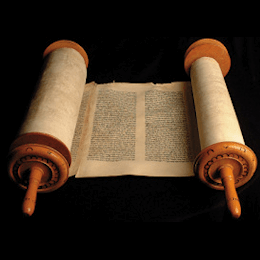Textus Receptus Bibles
Masoretic Text 1524
Old Testament
| 27:1 | לדוד יהוה אורי וישׁעי ממי אירא יהוה מעוז חיי ממי אפחד׃ |
| 27:2 | בקרב עלי מרעים לאכל את בשׂרי צרי ואיבי לי המה כשׁלו ונפלו׃ |
| 27:3 | אם תחנה עלי מחנה לא יירא לבי אם תקום עלי מלחמה בזאת אני בוטח׃ |
| 27:4 | אחת שׁאלתי מאת יהוה אותה אבקשׁ שׁבתי בבית יהוה כל ימי חיי לחזות בנעם יהוה ולבקר בהיכלו׃ |
| 27:5 | כי יצפנני בסכה ביום רעה יסתרני בסתר אהלו בצור ירוממני׃ |
| 27:6 | ועתה ירום ראשׁי על איבי סביבותי ואזבחה באהלו זבחי תרועה אשׁירה ואזמרה ליהוה׃ |
| 27:7 | שׁמע יהוה קולי אקרא וחנני וענני׃ |
| 27:8 | לך אמר לבי בקשׁו פני את פניך יהוה אבקשׁ׃ |
| 27:9 | אל תסתר פניך ממני אל תט באף עבדך עזרתי היית אל תטשׁני ואל תעזבני אלהי ישׁעי׃ |
| 27:10 | כי אבי ואמי עזבוני ויהוה יאספני׃ |
| 27:11 | הורני יהוה דרכך ונחני בארח מישׁור למען שׁוררי׃ |
| 27:12 | אל תתנני בנפשׁ צרי כי קמו בי עדי שׁקר ויפח חמס׃ |
| 27:13 | לולא האמנתי לראות בטוב יהוה בארץ חיים׃ |
| 27:14 | קוה אל יהוה חזק ויאמץ לבך וקוה אל יהוה׃ |

Masoretic Text 1524
The Hebrew text of the Old Testament is called the Masoretic Text because in its present form it is based upon the Masora—the Hebrew, textual tradition of the Jewish scholars known as the Masoretes (or Masorites). The Masoretes were rabbis who made it their special work to correct the faults that had crept into the text of the Old Testament during the Babylonian captivity, and to prevent, for the future, its being corrupted by any alteration. They first separated the apocryphal from the canonical books, and divided the latter into twenty-two books, being the number of letters in the Hebrew alphabet. Then they divided each book into sections and verses.
There is a great difference of opinion as to when the Masoretic Text was written, but it was probably accomplished in the 10th -11th century. Several editions existed, varying considerably, but the received and authoritative text is that of Jacob ben-chayim ibn Adonijah, who carefully sifted and arranged the previous works on the subject. It was published in 1524.